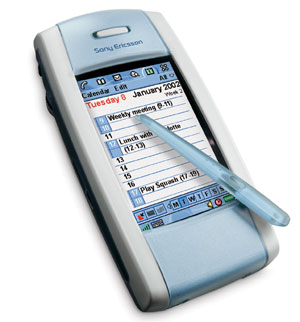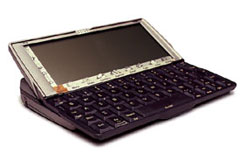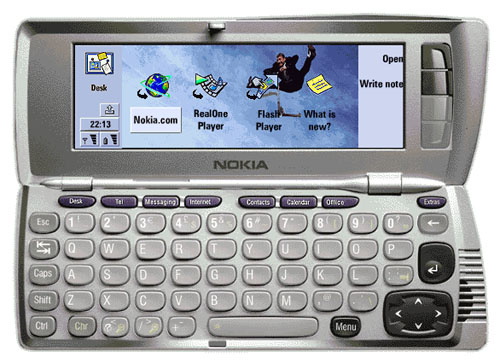Introduction
 |
Smartphones and communicators - those words are already firmly entrenched in our everyday vocabulary. Handheld devices are increasingly part of our lives. Of the expensive toys that are available only a very secured the people, they are gradually becoming an essential attribute of modern humans, and not only a businessman. Mobility - that is the keyword of modern information technology. For a start I would like some clarification of terminology. Under the usual smartphone is commonly understood bezklaviaturnoe device (like a Sony Ericsson P800), primarily designed for data access and designed for a wide range of users, the communicator is commonly called a functional device with keyboard, large screen and oriented generally more " professional "users. Equipped with high-speed data functions such as GPRS or HSCSD, such a device allows a person to constantly be on the "edge" of events, receive email, browse Web pages, work with documents, faxes and so on. Not all agree to wear a bag or briefcase heavy full-sized notebook. Apart from the fact that most of the computing power just idling, the low battery life does not give the opportunity to work, for example, all the time during a long flight or trip. In addition, the low reliability of widespread operating system for desktop machines (especially the notorious family of Windows 9x), their poor suitability for use in mobile devices, excessive requirements to hardware resources (especially memory and disk space), the possibility of mechanical damage to computer components (especially refers to hard drives) make use of these expensive and bulky devices unjustified. High demands of modern mobile devices, particularly in terms of power consumption and reliability of operating systems and programs to fail food that caused the market for new operating systems designed with these requirements. It is for these devices and was created by Symbian OS (formerly EPOC 32).
The story of Symbian OS
Operating System Symbian OS (EPOC 32) was developed by Symbian - a joint venture firms Motorola, Ericsson, Nokia and Psion-based Psion Software division of Psion. Later they were joined by company Matsushita, Kenwood, Fujitsu, Siemens and others. The first release ("Release») EPOC 32 in April 1997 marked the birth of a new generation of operating systems based on extensive experience in the industry the company Psion handheld mobile devices. For thirteen years before, in 1984, the company Psion has invented a personal organizer. With sales of the next model - Organiser II - corporate and private clients with more than one million units. This model had an 8-bit CPU, and could be programmed in assembly language or BASIC-like high level language OPL (Organiser Programming Language). Since 1991, a series of devices under a common brand Psion Series 3 Take a personal digital organizer popular and affordable mass-market device. The new OS is called SIBO (SIxteen-Bit Organiser), often it is also called SYMBIAN OS16. In the system of SIBO was first applied technology is the core allocation and application interfaces into separate components, which subsequently became an integral and important part of the 32-bit SYMBIAN OS. However, since most of the core system was written in assembly language, but also because of the restrictions for 16-bit architecture x86, SIBO system could not be used anywhere except processors x86. Graphical frontend SIBO was an object-oriented, and built-in editor and translator of the language OPL allows them to be directly on your PDA. Platform SIBO A myriad of applications. At the same time for the corporate market has been developed industrial terminal WorkAbout, first introduced in 1995. Total sales of devices has exceeded 1.5 million units.In the period of greatest popularity in the share of Series 3 accounted for 35% of world market organizers. One major reason for this was the convenience and functionality of applications SIBO, reliability and efficiency of multi-tasking operating system (which throughout its existence was virtually no errors found), high quality built-in ROM software, long battery life and stylish design firm.
 |
Over time, handheld computers become more powerful. By 1994, a limit of 64KB, which is characteristic for 16-bit systems have become a serious obstacle to the development of software is also becoming clear that the system of this class should be portable to a wider range of devices. So a new system SYMBIAN OS. Retaining the best features of previous OS Psion, it was to be fully 32-bit portable to any hardware platform and architecture. This would allow SYMBIAN OS to become an open system, available for licensing to third-party manufacturers of mobile devices. To this end, the group Psion has been allocated an independent company to develop software - Psion Software. The new system was to become the standard for wireless information devices by licensing a broad range of manufacturers of this industry. In April 1997 came the first version SYMBIAN OS - Release 1 - and immediately at its base the new product: Psion Series 5. Licensing of the new OS had begun even before its official publication. SYMBIAN OS, with its efficiency and flexibility, as well as high technical standard Symbian (formerly Psion Software) have formed a very good basis for creating a new system software for wireless devices. The company Psion Software was selected from a group of companies Psion Group, and changed its name to Symbian Ltd, becoming a joint venture between Ericsson, Nokia, Motorola and Psion. From the outset the system was designed as a fully object-oriented. As the language has been chosen C + + as the most powerful and most complex to date, object-oriented programming language.
Goal of creating a Symbian OS (SYMBIAN OS 32)
Attractiveness to Users
Mobile devices are intended for personal use. They should be easy to use, and always provide information on demand (the principle of "Instant-On"). System graphical user interface and firmware must be attractive and intuitive. An efficient multi-tasking. Power management should allow the computer when you switch instantly restore the state in which he was at the time off without the long process of booting the system. When replacing the power source (batteries) data should be preserved. Software in ROM should be of the highest quality. These lessons the company learned Psion back in time Organiser II, when the majority of desktop PCs were running DOS, a "portable" computer was the size of a diplomat. Suite of applications - a critical factor for creating attractive from the standpoint of the end user. SYMBIAN OS applications are designed with the expectation and the beginner and professional. About ten major applications and the entire operating system had to fit in a ROM, which amounts to about 1 / 10 of the average application for the PC. Such a compact has been achieved by the highest degree of reusability, the use of object-oriented design, C + + language and the tight junction development teams dealing with various aspects of the OS and applications. Digital communications are widely used in today's world. SIBO architecture was designed for organizers who are independent units, which only rarely had to communicate with other devices for data backup. Devices based on SIBO well have existed without connection to a PC.Currently, communications using the Internet, fax and mobile phones has become commonplace, and synchronized with the data on the desktop, at home and at work, has become extremely important for mobile devices. Mechanisms of synchronization and data sharing were originally built into the Symbian OS.
Attractive for OEM-manufacturers
OS Series devices Organiser and SIBO was used only in products of companies of the group Psion. Symbian OS was designed from the outset in order to license a wide range of telecom equipment manufacturers. The main requirement was portability for different types of processors. This, in turn, required the use of high-level language, which could simply be transferred to another platform. Assembly language is used only for implementation of components, which is especially important for speed of execution. In Symbian OS is also widely used abstraction from a particular type of equipment that make it easier to adapt for different variants of a single processor architecture. Despite the fact that SYMBIAN OS is a portable system as the main platform was chosen by Symbian architecture ARM. ARM architecture is exceptionally efficient RISC-strutura providing optimal ratio of performance / power consumption - which is especially important for devices that must operate for weeks on one set of batteries. In addition, through effective use of chip area and correct the company's policy ARM Ltd in respect of licensing ARM architecture provides the best ratio performance / price. ARM architecture licensed these "whales" as Intel, Nokia, etc. Mobile devices are no standards for screen size, keyboard shortcuts, or digitizer. Producers receive complete freedom to create any types of devices, any price range, size and weight. Symbian company made a strategic decision to make a clear separation between the graphical user interface (GUI) and other components. For devices that require non-standard means of user interaction, graphical interface system and applications can be modified or completely redesigned. For example, it will easily adapt to any size and screen resolution, absence / presence of a touch screen, etc. Compared with other platforms it will allow manufacturers of devices based on SYMBIAN OS to create devices with "branded" look and feel of hardware. SYMBIAN OS is an international operating system. Platform SIBO was localized for the UK and the U.S., almost all the languages of Western Europe, and parts of Eastern European languages: Czech, Hungarian, Greek and Russian. IN SYMBIAN OS built-in support for 16-bit encoding UNICODE and special means of data entry to adapt to the languages of Asia and the Far East, such as Japanese, Chinese, Korean and Thai.
Attractive to developers
In order to develop efficient applications using a wide range of advanced development tools. The main requirement was a 32-bit OS, since the writing of applications for SIBO (as for DOS / Windows 3.1) required a significant effort to overcome the limitations in the 64K at the size of the segment caused by using 16-bit architecture to x86. SYMBIAN OS is fully 32-bit, there is no support for older 16-bit programming interfaces (API) is missing. Symbian provides a wide range of development tools for SYMBIAN OS. Program in standard C + + language are created on a PC using an interactive development environment Microsoft Visual Studio and emulator. Then the source code is recompiled and transferred to a PC based on ARM processor with the compiler GNU C + +. It is also possible to develop applications in OPL (similar to the BASIC language), whose roots go back in the days Organiser II. There is also the possibility of writing Java programs using any of the existing development tools for the language Java. On creation of development tools for Symbian OS announced by companies such as Metrowerks (known for its tools CodeWarrior), AppForge (presented the means to develop software for Symbian OS language Visual Basic) and Borland, traditionally strong in the field of visual development tools.
 |
Development History SYMBIAN OS
| Version | Release date | Features | Where Used |
| Release 1 | April 1997 | First edition. The new OS with a set of office applications. | Psion Series 5 1.00 ROM |
| Release 2 | July 1997 | Released a package for PC EPOC Connect, fixes some bugs, added the application EasyFax | Psion Series 5 1.01 ROM, PsiWin 2.0 |
| Release 3 | November 1997 | Email applications are included and the Web, support for remote access and TCP / IP | Geofox One, PCC Synergy |


